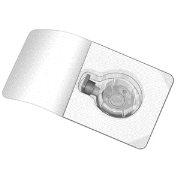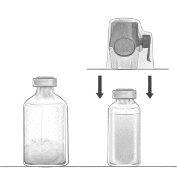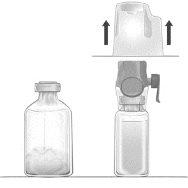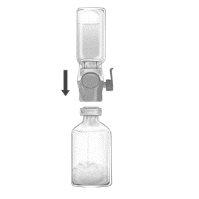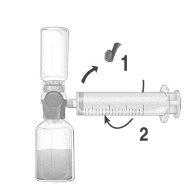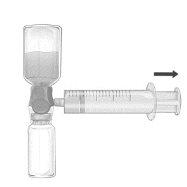
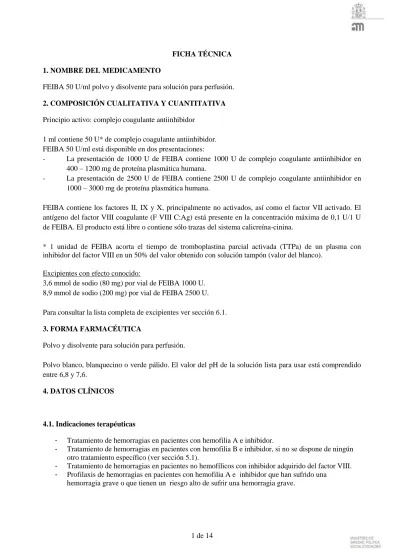
ФЕЙБА 100 ОД/мл ПОРОШОК І РОЗЧИННИК ДЛЯ ПРИГОТУВАННЯ РОЗЧИНУ ДЛЯ ІНФУЗІЙ

Запитайте лікаря про рецепт на ФЕЙБА 100 ОД/мл ПОРОШОК І РОЗЧИННИК ДЛЯ ПРИГОТУВАННЯ РОЗЧИНУ ДЛЯ ІНФУЗІЙ

Інструкція із застосування ФЕЙБА 100 ОД/мл ПОРОШОК І РОЗЧИННИК ДЛЯ ПРИГОТУВАННЯ РОЗЧИНУ ДЛЯ ІНФУЗІЙ
Введення
Опис: інформація для користувача
FEIBA 100Од/мл порошок і розчинник для розчину для інфузії
антитромботичний коагулянтний комплекс
Всієї інформації цього опису перед початком використання цього лікарського засобу, оскільки вона містить важливу інформацію для вас.
- Збережіть цей опис, оскільки вам може знадобитися знову його прочитати.
- Якщо у вас виникли питання, проконсультуйтеся з вашим лікарем або фармацевтом.
- Цей лікарський засіб призначений тільки вам, і його не слід давати іншим людям, навіть якщо вони мають相同ні симптоми, оскільки це може нашкодити їм.
- Якщо ви відчуваєте побічні ефекти, проконсультуйтеся з вашим лікарем або фармацевтом, навіть якщо це побічні ефекти, які не вказані в цьому описі. Див. розділ 4.
Зміст опису
- Що таке FEIBA і для чого він використовується
- Що потрібно знати перед початком використання FEIBA
- Як використовувати FEIBA
- Можливі побічні ефекти
- Зберігання FEIBA
- Зміст упаковки та додаткова інформація
1. Що таке FEIBA і для чого він використовується
FEIBA - це препарат, виготовлений з людської плазми, який дозволяє гемостаз, навіть якщо кількість конкретних факторів коагуляції знижена або відсутня.
FEIBA використовується для лікування та профілактики кровотеч у пацієнтів з гемофілією А з інгібітором.
FEIBA використовується для лікування кровотеч у пацієнтів з гемофілією Б з інгібітором.
FEIBA можна використовувати для лікування та профілактики кровотеч у пацієнтів, які не мають гемофілії, з набутим інгібітором фактору VIII.
Крім того, FEIBA використовується для профілактики під час хірургічних втручань у пацієнтів з гемофілією А з інгібітором.
FEIBA можна використовувати у всіх вікових групах.
2. Що потрібно знати перед початком використання FEIBA
Повідомте вашого лікаря, якщо у вас є відомі алергічні реакції.
Повідомте вашого лікаря, якщо ви дотримуєтеся дієти з низьким вмістом натрію.
Не використовувати FEIBA
FEIBA слід використовувати тільки в таких випадках, якщо, наприклад, через дуже високий титр інгібіторів не очікується жодної реакції на лікування концентратом фактору коагуляції:
- якщо ви алергічні (гіперчутливі) до антитромботичного коагулянтного комплексу або до будь-якого іншого компонента цього лікарського засобу (перелічених у розділі 6).
- якщо існує дисемінована внутрішньосудинна коагуляція (ДВК). (ДВК = коагулопатія споживання, потенційно смертельна умову, при якій відбувається надмірна коагуляція крові з утворенням коагулів у кровоносних судинах. Це призводить до споживання факторів коагуляції у всьому організмі).
- у разі інфаркту міокарда, тромбозу та/або емболії: FEIBA слід використовувати тільки у випадках геморагічних епізодів, які становлять загрозу для життя.
Попередження та застереження
Проконсультуйтеся з вашим лікарем перед початком використання FEIBA, оскільки можуть виникнути реакції гіперчутливості, як у випадку з усіма препаратами, що походять з плазми та вводяться внутрішньовенно. Для того, щоб визначити алергічну реакцію якомога раніше, потрібно знати, що перші потенційні симптоми реакції гіперчутливості можуть бути:
- еритема (червоність шкіри)
- висип
- утворення пухирів на шкірі (кропив'янка)
- свербіж по всьому тілу
- набухання губ і язика
- затруднення дихання/диспное
- стиснення в грудній клітці
- загальне нездужання
- нудота
- падіння артеріального тиску
Інші симптоми реакцій гіперчутливості до препаратів, що походять з плазми, включають летаргію та втому.
Якщо ви помітили будь-які з цих симптомів, потрібно негайно припинити введення та звернутися до вашого лікаря. Ці симптоми можуть свідчити про анафілактичний шок. Тяжкі симптоми потребують раннього лікування.
Ваш лікар буде знову використовувати FEIBA тільки у пацієнтів з підозрою на гіперчутливість до препарату або до будь-якого з його компонентів після ретельної оцінки очікуваної користі та ризику повторного введення та/або відсутності реакції на інше профілактичне лікування або альтернативну терапію.
- Якщо ви відчуваєте значні зміни артеріального тиску або частоти серцевих скорочень, труднощі з диханням, кашель або біль у грудній клітці, потрібно негайно припинити введення та звернутися до вашого лікаря. Ваш лікар розпочне відповідні діагностичні та терапевтичні заходи.
- У пацієнтів з гемофілією з інгібіторами або з набутими інгібіторами факторів коагуляції. Під час лікування FEIBA ці пацієнти можуть мати підвищену схильність до розвитку кровотеч та підвищений ризик тромбозу одночасно.
Під час лікування FEIBA виникли тромботичні та тромбоемболічні події, включаючи дисеміновану внутрішньосудинну коагуляцію (ДВК), тромбоз глибоких вен, пульмональну емболію, інфаркт міокарда та інсульт. Ймовірно, що використання фактору VIIа рекомбінантного разом з FEIBA збільшує ризик розвитку тромбоемболічного події. Деякі з цих тромбоемболічних подій відбулися при високих дозах FEIBA.
У одному з досліджень, проведених іншою компанією для оцінки емісізумабу (лікарського засобу для профілактики кровотеч у пацієнтів з гемофілією А), деякі пацієнти, які мали міжчасові кровотечі, були-treated з FEIBA для контролю кровотеч, і деякі з цих пацієнтів розвинули мікроангіопатію тромботичної (МАТ). МАТ - це важка та потенційно загрозлива для життя умову, при якій може бути пошкоджена судинна стінка та розвинутися коагули в малих кровоносних судинах. В деяких випадках це може призвести до пошкодження нирок та інших органів. У разі міжчасових кровотеч під час профілактики емісізумабом негайно зверніться до вашого гематолога або центру лікування гемофілії.
Коли вводяться лікарські засоби, що походять з плазми або крові людини, потрібно проводити певні заходи для уникнення передачі інфекцій пацієнтам. Такі заходи включають ретельний відбір донорів, щоб виключити тих, хто знаходиться в групі ризику бути носіями інфекційних захворювань, аналіз маркерів інфекцій у індивідуальних донорських матеріалах та плазмових сумішах, а також включення етапів у процесі виробництва для ліквідації/інактивації вірусів. Незважаючи на це, коли вводяться лікарські засоби, що походять з крові або плазми людини, можливість передачі інфекційних агентів не можна повністю виключити. Це також стосується нових чи невідомих вірусів чи інших типів інфекцій.
Ці заходи вважаються ефективними для вірусів з оболонкою, таких як вірус імунодефіциту людини (ВІЛ), вірус гепатиту Б та вірус гепатиту С, а також для вірусів без оболонки, таких як вірус гепатиту А. Заходи, прийняті для ліквідації/інактивації вірусів, можуть мати обмежену цінність для вірусів без оболонки, таких як парвовірус В19. Інфекція парвовірусом В19 може бути важкою для вагітної жінки (фетальна інфекція) та для осіб з ослабленим імунітетом або пацієнтів з певними типами анемії (наприклад, хвороба дрепаноціту або гемолітична анемія).
Можливо, ваш лікар порекомендує вакцинацію проти гепатиту А та гепатиту Б, якщо вам регулярно або повторно вводяться лікарські засоби, що походять з плазми, для інгібіторів фактору VIII.
Після введення високих доз FEIBA тимчасове підвищення рівня пасивно переданих антитіл до поверхні гепатиту Б може спричинити неправильну інтерпретацію результатів серологічних тестів.
FEIBA - це препарат, що походить з плазми, і може містити речовини, які реагують при введенні пацієнтам, спричинюючи появу ізогемаглютинінів (антитіл, які спричинюють прилипання червоних кров'яних тілець іншої людини). Цей процес може привести до неправильної інтерпретації результатів аналізів крові.
Рекомендується зберігати запис про введення кожного лікарського засобу з вказанням назви лікарського засобу та номера серії з метою зберігання реєстру використаних серій.
Діти
Досвід використання у дітей молодших 6 років обмежений; слід застосовувати相同ну схему дозування, як у дорослих, з урахуванням клінічного стану дитини.
Інші лікарські засоби та FEIBA
Повідомте вашого лікаря або фармацевта, якщо ви використовуєте, нещодавно використовували або можете використовувати будь-які інші лікарські засоби.
Не проводилися достатні та добре контрольовані дослідження щодо спільного або послідовного використання FEIBA та фактору VIIа рекомбінантного, антифібринолітиків або емісізумабу. Коли використовуються системні антифібринолітики, такі як транексамова кислота та амінокапронова кислота, під час лікування FEIBA слід враховувати можливість виникнення тромбоемболічних подій. Тому не слід використовувати антифібринолітики до приблизно 6-12 годин після введення FEIBA.
За наявними даними in vitro та клінічними спостереженнями не можна виключити потенційну взаємодію лікарських засобів при спільному використанні з фактором VIIа рекомбінантним, який потенційно може призвести до тромбоемболічної події. Повідомте вашого лікаря, якщо ви будете лікуватися FEIBA після прийому емісізумабу (лікарського засобу для профілактики кровотеч у пацієнтів з гемофілією А), оскільки потрібно враховувати певні особливості попередження та застереження. Ваш лікар буде проводити тісний моніторинг.
Як і з усіма препаратами, що використовуються для коагуляції крові, FEIBA не слід змішувати з іншими лікарськими засобами перед введенням, оскільки це може вплинути на ефективність та толерантність препарату. Застосування ізотонічного солевого розчину для промивання венозної ділянки перед та після введення FEIBA є доцільним.
Вагітність, лактація та фертильність
Якщо ви вагітні або перебуваєте у період лактації, вважаєте, що можете бути вагітною або плануєте вагітність, проконсультуйтеся з вашим лікарем або фармацевтом перед використанням цього лікарського засобу.
Ваш лікар вирішить, чи можна використовувати FEIBA під час вагітності та лактації. Через підвищений ризик тромбозу під час вагітності FEIBA слід застосовувати тільки під тісним медичним наглядом та тільки у випадках, коли це явно показано. Для інформації про ризик інфекції парвовірусом В19 див. розділ попередження та застереження.
Водіння транспортних засобів та використання машин
Немає жодних ознак того, що FEIBA може впливати на здатність водіння транспортних засобів та використання машин.
FEIBA містить натрій
500 Од
Цей лікарський засіб містить приблизно 40 мг натрію (основної складової кухонної солі) у кожній флаконі. Це відповідає 2% від максимальної добової норми споживання натрію, рекомендованої для дорослих.
1 000 Од
Цей лікарський засіб містить приблизно 80 мг натрію (основної складової кухонної солі) у кожній флаконі. Це відповідає 4% від максимальної добової норми споживання натрію, рекомендованої для дорослих.
2 500 Од
Цей лікарський засіб містить приблизно 200 мг натрію (основної складової кухонної солі) у кожній флаконі. Це відповідає 10% від максимальної добової норми споживання натрію, рекомендованої для дорослих.
3. Як використовувати FEIBA
Перед використанням FEIBA потрібно відновити порошок шляхом змішування з розчинником, який входять до складу препарату, та ввести розчин внутрішньовенно.
Слідувати точно інструкціям щодо введення цього лікарського засобу, вказаним вашим лікарем. У разі сумнівів проконсультуйтеся з вашим лікарем або фармацевтом.
Ваш лікар визначить частоту та дозу, необхідну для вас особисто, враховуючи тяжкість порушення коагуляції крові, місце та ступінь кровотечі, а також клінічний стан та реакцію на препарат. Не змінюйте встановлену вашим лікарем дозування та не припиняйте введення препарату.
Якщо ви вважаєте, що дія FEIBA надто сильна або надто слабка, проконсультуйтеся з вашим лікарем або фармацевтом.
Розігріти продукт до кімнатної температури або температури тіла перед введенням, якщо це необхідно.
FEIBA слід відновлювати негайно перед введенням. Розчин слід використовувати негайно (оскільки препарат не містить консервантів).
Агітувати nhẹ до повного розчинення препарату. Забезпечити, щоб FEIBA був повністю розчинений, оскільки в іншому випадку активна речовина може залишитися у фільтрі обладнання.
Розчини, які мають мутний вигляд або містять осад, слід видалити.
Не повторно використовувати відкриті флакони.
Використовувати тільки воду для ін'єкцій та обладнання для відновлення, які входять до складу препарату.
Якщо використовуються інші обладнання, ніж ті, які входять до складу препарату, слід використовувати фільтр з розміром пор не менше 149 мкм.
Не використовувати продукт, якщо система бар'єру стерильності або упаковка пошкоджені або показують будь-які ознаки псування.
Не зберігати у холодильнику після відновлення.
Після повного відновлення FEIBA введення або інфузія слід розпочинати негайно та завершувати протягом 3 годин після відновлення.
Видалення невикористаного лікарського засобу та всіх матеріалів, які були в контакті з ним, здійснюється згідно з місцевими правилами.
Відновлення порошку для приготування розчину для інфузії з допомогою обладнання BAXJECT II Hi-Flow:
- Розігріти невідкритий флакон розчинника (вода для ін'єкцій) до кімнатної температури або максимально 37°C, якщо це необхідно, наприклад, за допомогою водяної ванни протягом декількох хвилин.
- Зняти захисні ковпачки з флакону порошку та флакону розчинника, та продезінфікувати гумові ковпачки обох флаконів. Помістити флакони на рівну поверхню.
- Відкрити упаковку обладнання BAXJECT II Hi-Flow, знявши захисну плівку, не торкаючись вмісту упаковки (Фігура а). Не виймати обладнання з упаковки.
- Перевернути упаковку та вставити прозорий пластиковий наконечник через гумовий ковпачок флакону розчинника (Фігура б). Виняти обладнання BAXJECT II Hi-Flow з упаковки (Фігура в). Не знімати захисний синій ковпачок обладнання BAXJECT II Hi-Flow.
- З'єднати обладнання BAXJECT II Hi-Flow з флаконом розчинника, перевернути систему так, щоб флакон розчинника був у верхній частині обладнання. Вставити фіолетовий пластиковий наконечник обладнання BAXJECT II Hi-Flow через гумовий ковпачок флакону FEIBA. Вакуум спричинить проникнення розчинника до флакону FEIBA (Фігура г).
- Агітувати nhẹ все обладнання, не викликаючи турбулентності, до повного розчинення порошку. Забезпечити, щоб FEIBA був повністю розчинений, оскільки в іншому випадку активна речовина може залишитися у фільтрі обладнання.
Фігура а | Фігура б | Фігура в |
|
|
|
Інфузія
Використовувати асептичну техніку протягом усього процедури!
- Зняти захисний синій ковпачок обладнання BAXJECT II Hi-Flow. З'єднати шприц з обладнання BAXJECT II Hi-Flow. НЕ ВПРОВАДЖАЙТЕ ПОВІТРЯ В ШПРИЦ. (Фігура д). Рекомендується використовувати шприц Luer Lock, щоб забезпечити щільне з'єднання між шприцем та обладнання BAXJECT II Hi-Flow (повернути шприц за годинниковою стрілкою до зупинки).
- Перевернути систему так, щоб розчинений препарат був у верхній частині. Впровадити розчинений препарат до шприца, тягнувши поршень назад ПОВІЛЬНО та забезпечуючи щільне з'єднання між обладнання BAXJECT II Hi-Flow та шприцем під час всього процесу введення поршня шприца (Фігура е).
- Від'єднати шприц.
- Якщо утворилася піна всередині шприца, дочекатися, поки піна не компактується. Ввести розчинений препарат повільно внутрішньовенно за допомогою обладнання для інфузії.
Фігура г | Фігура д | Фігура е |
|
|
|
Не перевищувати швидкість інфузії 10 Од FEIBA/кг на хвилину.
Якщо ви використали більше FEIBA, ніж потрібно
Негайно повідомте вашого лікаря. Передозування FEIBA може збільшити ризик побічних ефектів, таких як тромбоемболія (утворення коагуляції крові з червонінням у кровоносних судинах), дисемінована внутрішньосудинна коагуляція (ДВК) або інфаркт міокарда. Деякі з цих тромбоемболічних подій відбулися при високих дозах FEIBA. Якщо спостерігаються ознаки або симптоми тромбоемболічної події, інфузію слід негайно припинити та провести необхідні діагностичні та терапевтичні заходи.
У разі передозування або випадкового прийому лікарського засобу негайно зверніться до вашого лікаря або фармацевта або телефонуйте до служби токсикологічної інформації, телефон 91 562 04 20, вказуючи назву лікарського засобу та кількість, прийняту.
4. Можливі побічні ефекти
Як і всі лікарські засоби, цей лікарський засіб може спричиняти побічні ефекти, хоча не всі люди їх переживають.
Часті побічні ефекти(можуть впливати до 1 з 10 пацієнтів)
Гіперчутливість, головний біль, головокружіння, гіпотонія, висип на шкірі, позитивні поверхневі антигени гепатиту Б.
Побічні ефекти з невідомою частотою(не можуть бути оцінені на основі наявних даних)
Розлади крові та лімфатичної системи:дисемінована внутрішньосудинна коагуляція (ДВК), підвищення рівня інгібітора.
Розлади імунної системи:анафілактичні реакції, висип на шкірі по всьому тілу (кропив'янка).
Розлади нервової системи:відчуття оніміння кінцівок (гіпостезія), аномальне або знижене чуття (парестезія), інсульт (тромботичний або емболічний інсульт), сонливість, порушення смаку (дисгезія).
Розлади серцево-судинної системи:серцевий напад (інфаркт міокарда), серцебиття (тахікардія).
Розлади судин:утворення кров'яних згустків з почервонінням судин (тромбоемболічні події, венозний і артеріальний тромбоз), підвищення артеріального тиску (гіпертонія), червоність.
Розлади дихальної, грудної та медіастинальної систем:обструкція легеневої артерії (легенева емболія), обструкція дихальних шляхів (бронхоспазм), свист у грудній клітці, кашель, труднощі з диханням (диспное).
Розлади травної системи:блювота, діарея, нездужання в животі, відчуття захворювання (нудота).
Розлади шкіри та підшкірної клітковини:відчуття оніміння на обличчі, набряк обличчя, язика та губ (ангіоедем), висип на шкірі по всьому тілу (кропив'янка), свербіж (прурит).
Розлади загального стану та зміни в місці введення:біль в місці ін'єкції, загальне нездужання, відчуття жару, озноби, гарячка, біль у грудній клітці, нездужання в грудній клітці.
Додаткові дослідження:падіння артеріального тиску, підвищення рівня Д-димеру фібрину в крові.
Швидка внутрішньовенна інфузія може спричиняти гострий біль і відчуття оніміння на обличчі та кінцівках, а також зниження артеріального тиску.
Було повідомлено про випадки інфаркту міокарда після введення доз, що перевищують максимальну добову дозу, і/або при тривалому введенні і/або наявності факторів ризику тромбоемболічних подій.
Сповіщення про побічні ефекти
Якщо ви переживаєте будь-який побічний ефект, зверніться до свого лікаря, навіть якщо це можливі побічні ефекти, які не вказані в цьому листку.
Ви також можете повідомити про них безпосередньо через Іспанську систему фармакологічного нагляду за лікарськими засобами для людини: www.notificaram.es.
Сповіщення про побічні ефекти дозволяє вам сприяти наданню більшої інформації про безпеку цього лікарського засобу.
5. Зберігання ФЕІБА
Тримати цей лікарський засіб поза зоною видимості та доступу дітей.
Не зберігати при температурі вище 25 °C. Не заморожувати.
Зберігати в оригінальній упаковці для захисту від світла.
Не використовувати цей лікарський засіб після закінчення терміну придатності, вказаного на етикетці та упаковці. Термін придатності - останній день місяця, вказаного на упаковці.
Лікарські засоби не повинні викидатися у водопровідні труби чи сміття. Спитайте у свого фармацевта, як позбутися упаковок та лікарських засобів, які вам більше не потрібні. Таким чином, ви допоможете захистити навколишнє середовище.
6. Зміст упаковки та додаткова інформація
Склад FEIBA
Порошок
- Активний інгредієнт на флаконі - антиінгібіторний коагуляційний комплекс.
- 1 мл містить 100 ОД антиінгібіторного коагуляційного комплексу.
- FEIBA 100 ОД/мл випускається у трьох видах:
- Форма випуску 500 ОД FEIBA містить 500 ОД (одиниць) антиінгібіторного коагуляційного комплексу у 200–600 мг плазмових білків людини.
- Форма випуску 1000 ОД FEIBA містить 1000 ОД (одиниць) антиінгібіторного коагуляційного комплексу у 400–1200 мг плазмових білків людини.
- Форма випуску 2500 ОД FEIBA містить 2500 ОД (одиниць) антиінгібіторного коагуляційного комплексу у 1000–3000 мг плазмових білків людини.
FEIBA також містить фактори II, IX і X, в основному неактивовані, а також активований фактор VII. Антиген фактору VIII згортання крові (FVIII C:Ag), а також фактори системи калікреїн-кінін присутні лише у слідових кількостях.
- Інші компоненти - хлорид натрію та цитрат натрію.
Розчинник
- Вода для ін'єкційних препаратів.
Вигляд продукту та вміст упаковки
Продукт випускається у вигляді лioфілізованого або крихкого порошку білого або блідо-жовтого кольору. Розчин, відновлений з порошку, має pH між 6,5 і 7,3.
Порошок і розчинник поставляються у скляних флаконах, закритих гумовими пробками.
Вигляд:1 × 500 ОД
1 × 1000 ОД
1 × 2500 ОД
Можливо, що тільки деякі розміри упаковок будуть випускатися.
Вміст упаковки:
- 1 флакон з 500 ОД/1000 ОД/2500 ОД FEIBA - порошок для розчину для інфузії
- 1 флакон з 5 мл/10 мл/25 мл води для ін'єкційних препаратів
- 1 набір для відновлення BAXJECT II Hi-Flow
- 1 одноразова шприц
- 1 голка-бабочка
Власник дозволу на розміщення продукції на ринку та відповідальна особа за виробництво
Власник дозволу на розміщення продукції на ринку:
Baxalta Innovations GmbH
Industriestrasse, 67
1221 Відень, Австрія
Відповідальна особа за виробництво:
Takeda Manufacturing Austria AG
Industriestrasse, 67
1221 Відень, Австрія
Місцевий представник власника дозволу
Takeda Фармацевтика Іспанія, С.А.
Вулиця Альбасете, 5, 9-й поверх,
Будинок Los Cubos
28027 Мадрид
Іспанія
Телефон: +34 91 790 42 22
Цей лікарський засіб дозволений в державах-членах Європейського економічного простору під наступними назвами:
Австрія:
FEIBA 100 Ед/мл Порошок і розчинник для інфузійної розв'язки
Болгарія:
FEIBA 100 ОД/мл Порошок і розчинник для розв'язки для інфузії
Хорватія:
FEIBA 100 ОД/мл Порошок і розчинник для інфузійної розв'язки
Кіпр:
FEIBA 100 ОД/мл Порошок і розчинник для інфузійної розв'язки
Чехія:
FEIBA
Данія:
Feiba
Естонія:
FEIBA 100 Єд/мл
Фінляндія:
Feiba
Німеччина:
FEIBA 500 Е концентрований
FEIBA 1000 Е концентрований
FEIBA 2500 Е концентрований
Греція:
FEIBA 100 ОД/мл Порошок і розчинник для інфузійної розв'язки
Ірландія:
FEIBA 100 ОД/мл Порошок і розчинник для розв'язки для інфузії
Латвія:
Feiba 100 Єд/мл Порошок і розчинник для інфузійної розв'язки
Литва:
Feiba 100 Єд/мл Порошок і розчинник для інфузійної розв'язки
Мальта:
FEIBA 100 ОД/мл Порошок і розчинник для розв'язки для інфузії
Нідерланди:
FEIBA 100 Ед/мл Порошок і розчинник для ін'єкційної розв'язки
Норвегія:
Feiba
Румунія:
FEIBA 100 ОД/мл Порошок і розчинник для ін'єкційної розв'язки
Словаччина:
FEIBA 100 ОД/мл Порошок і розчинник для інфузійної розв'язки
Словенія:
FEIBA 100 Єд/мл Порошок і розчинник для інфузійної розв'язки
Іспанія:
FEIBA 100 ОД/мл Порошок і розчинник для інфузійної розв'язки
Швеція:
Feiba 100 Єд/мл Порошок і розчинник для інфузійної розв'язки
Дата останнього перегляду цього листка:08/2024
Детальна інформація про цей лікарський засіб доступна на сайті Агентства лікарських засобів та медичних продуктів Іспанії (AEMPS) http://www.aemps.gob.es/
---------------------------------------------------------------------------------------------------------------------
Ця інформація призначена лише для фахівців галузі охорони здоров'я:
Лікування повинно бути розпочато і контролюватися під наглядом лікаря з досвідом лікування порушень згортання крові.
Дозування
Доза і тривалість терапії залежать від ступеня порушення гемостазу, місця і тяжкості кровотечі та клінічного стану пацієнта.
Доза і частота введення завжди встановлюються залежно від клінічної ефективності в кожному випадку.
Як загальне правило, рекомендується доза 50–100 ОД/кг FEIBA; не слід перевищувати одноразову дозу 100 ОД/кг або максимальну добову дозу 200 ОД/кг, якщо тільки тяжкість кровотечі не вимагає і не виправдовує використання вищих доз.
Через специфічні фактори пацієнтів, відповідь на агент обходу може варіюватися, і в ситуації з певною кровотечею пацієнти з недостатньою відповіддю на один агент можуть реагувати на інший агент. У разі недостатньої відповіді на агент обходу слід розглянути можливість використання іншого агента.
Педіатричне населення
Досвід використання у дітей молодших 6 років обмежений; слід застосовувати той же режим дозування, що і для дорослих, залежно від клінічного стану дитини.
- Спонтанні кровотечі
Кровотечі в суглобах, м'язах і м'яких тканинах
Для легких і середніх кровотеч рекомендована доза 50–75 ОД/кг кожні 12 годин. Лікування повинно продовжуватися до появи ясних ознак клінічної поліпшення, таких як зменшення болю, зменшення набухання або збільшення рухливості суглоба.
Для інтенсивних кровотеч у м'язах і м'яких тканинах, наприклад, кровотечі у ретроперитонеальному просторі, рекомендована доза 100 ОД/кг кожні 12 годин.
Кровотечі в слизових оболонках
Рекомендована доза 50 ОД/кг кожні 6 годин під суворим спостереженням за пацієнтом (візуальний контроль кровотечі, повторне визначення гематокриту). Якщо кровотеча не зупиняється, можна збільшити дозу до 100 ОД/кг; однак не слід перевищувати дозу 200 ОД/кг.
Інші інтенсивні кровотечі
При інтенсивних кровотечах, таких як кровотеча в центральній нервовій системі, рекомендована доза 100 ОД/кг кожні 12 годин. У окремих випадках можна вводити FEIBA кожні 6 годин, поки не з'являться ясні ознаки клінічної поліпшення (не слід перевищувати максимальну добову дозу 200 ОД/кг).
- Хірургічні операції
Під час хірургічних операцій можна вводити початкову дозу 100 ОД/кг перед операцією, а через 6–12 годин після операції - іншу дозу 50–100 ОД/кг. Як підтримуючу дозу після операції можна вводити 50–100 ОД/кг кожні 6–12 годин; доза, інтервали введення і тривалість лікування перед і після операції залежать від хірургічної операції, загального стану пацієнта і клінічної ефективності в кожному окремому випадку (не слід перевищувати максимальну добову дозу 200 ОД/кг).
- Профілактика у пацієнтів з гемофілією А з інгібітором
- Профілактика кровотеч у пацієнтів з високим титром інгібітора і частими кровотечами після невдалої спроби індукції імунотолерантності (ІТ) або коли така індукція не розглядається:
Рекомендована доза 70–100 ОД/кг через день. Якщо це необхідно, дозу можна збільшити до 100 ОД/кг на день або поступово зменшити.
- Профілактика кровотеч у пацієнтів з високим титром інгібітора під час індукції імунотолерантності (ІТ):
Можна вводити FEIBA в поєднанні з фактором VIII у інтервалі доз 50–100 ОД/кг двічі на день, поки титр інгібітора фактору VIII не знизиться до <2 ОБ.*< p>
* 1 одиниця Бетесди визначається як кількість антитіл, які інгібують 50% активності фактору VIII у плазмі, інкубованій (2 години при 37°C).
- Використання FEIBA у спеціальних групах пацієнтів
FEIBA також використовувався в поєднанні з концентратом фактору VIII як тривале лікування для повного і постійного усунення інгібітора фактору VIII.
Моніторинг
У разі недостатньої відповіді на лікування препаратом рекомендується провести підрахунок тромбоцитів, оскільки вважається необхідним достатня кількість функціонально цілих тромбоцитів для ефективності лікування препаратом.
Через складний механізм дії не існує прямого моніторингу активних інгредієнтів. Тести згортання крові, такі як час згортання крові, тромбоеластограма (ТЕГ, значення r) і час тромбопластини, зазвичай показують лише незначне скорочення, яке не завжди корелює з клінічною поліпшенням. Через ці причини корисність цих тестів для моніторингу лікування FEIBA дуже обмежена.
Форма введення
FEIBA повинен вводитися повільно внутрішньовенно. FEIBA повинен вводитися зі швидкістю 2 ОД/кг/хв. У пацієнтів, які добре перенесли швидкість введення 2 ОД/кг/хв, швидкість введення можна збільшити до максимальної - 10 ОД/кг/хв.
FEIBA повинен бути відновлений відразу перед введенням. Розчин повинен бути використаний негайно (оскільки препарат не містить консервантів). Не слід використовувати розчини з мутним виглядом або з осадом. Виведення невикористаного лікарського засобу та всіх матеріалів, які були в контакті з ним, повинно здійснюватися згідно з місцевими правилами.
Моніторинг терапії
Не слід перевищувати одноразові дози 100 ОД/кг або добові дози 200 ОД/кг. Пацієнтів, які отримують більше 100 ОД/кг, слід моніторити на предмет розвитку СІД та/або гострої ішемічної хвороби серця та на предмет симптомів тромботичних або тромбоемболічних подій. Для зупинки кровотечі слід вводити високі дози FEIBA лише протягом часу, який є суворо необхідним.
Якщо відбуваються клінічно значимі зміни артеріального тиску або частоти серцевих скорочень, труднощі з диханням, кашель або біль у грудній клітці, слід негайно припинити введення і провести необхідні діагностичні та терапевтичні заходи. Аналітичні параметри, характерні для СІД, - зниження фібриногену, зниження кількості тромбоцитів та/або присутність продуктів розкладу фібрину або фібриногену (ПРФ). Інші параметри для розвитку СІД - явне подовження часу тромбину, часу протромбину або часу тромбопластини. У пацієнтів з гемофілією з інгібітором або з набутими інгібіторами факторів VIII, IX і/або XI час тромбопластини часто подовжений через основне захворювання.
Введення FEIBA у пацієнтів з інгібітором може спричинити початковий "анамнезичний" зростання рівня інгібітора. Під час тривалого лікування FEIBA рівень інгібітора може знижуватися з часом. І клінічні дані, і опубліковані дані свідчать про те, що ефективність FEIBA не знижується.
Пацієнти з гемофілією з інгібітором або з набутими інгібіторами факторів згортання крові, які отримують лікування FEIBA, можуть бути більш схильні до кровотеч, а також можуть збільшити ризик тромбозу.
Лабораторні тести та клінічна ефективність
ВітроТести для контролю ефективності, такі як час тромбопластини, час згортання крові та тромбоеластограма, не завжди корелюють з клінічною поліпшенням. Через цю причину не слід намагатися нормалізувати ці значення шляхом збільшення дози FEIBA, навіть якщо це може бути небезпечним через можливий ризик розвитку СІД при передозуванні.
Важливість підрахунку тромбоцитів
У разі недостатньої відповіді на лікування FEIBA рекомендується провести підрахунок тромбоцитів, оскільки вважається необхідним достатня кількість функціонально цілих тромбоцитів для ефективності лікування FEIBA.
Лікування пацієнтів з гемофілією Б з інгібітором
Досвід використання у пацієнтів з гемофілією Б з інгібітором фактору IX обмежений через рідкість захворювання. П'ять пацієнтів з гемофілією Б з інгібітором були behandлені FEIBA під час клінічних досліджень, або з лікуванням за запитом, або з профілактичним лікуванням, або під час хірургічних операцій:
У одному клінічному дослідженні було випадковизовано 36 пацієнтів для отримання профілактичного лікування або лікування за запитом протягом 12 місяців ± 14 днів. 17 пацієнтів групи з профілактичним лікуванням отримували 85 ± 15 ОД/кг FEIBA, вводячи його через день, а 19 пацієнтів групи з лікуванням за запитом отримували індивідуальне лікування, визначене лікарем. Два пацієнти з гемофілією Б з інгібітором отримували лікування за запитом, а один пацієнт з гемофілією Б отримував профілактичне лікування. Медіана щорічної кількості кровотеч (СК) для всіх типів епізодів кровотеч у пацієнтів групи з профілактичним лікуванням (медіана СК = 7,9) була нижчою, ніж у пацієнтів групи з лікуванням за запитом (медіана СК = 28,7), що становить зниження медіани СК на 72,5% між групами лікування.
У іншому завершеному дослідженні безпеки спостереження за періопераційним використанням FEIBA (PASS-INT-003, SURF) було здійснено загалом 34 хірургічні операції у 23 пацієнтів. Більшість пацієнтів (18) мали спадкову гемофілію А з інгібітором, двоє були пацієнтами з гемофілією Б з інгібітором, а троє мали набуту гемофілію А з інгібітором. Час експозиції до FEIBA варіювався від 1 до 28 днів, із середнім значенням 9 днів і медіаною 8 днів. Середня накопичена доза становила 88 347 ОД, а медіана дози - 59 000 ОД. У пацієнтів з гемофілією Б з інгібітором найдовша тривалість експозиції до FEIBA становила 21 день, а максимальна введена доза - 7324 ОД.
Також у літературі описано 48 пацієнтів, у яких FEIBA використовувався для лікування та профілактики епізодів кровотеч у пацієнтів з гемофілією Б з інгібітором фактору IX (34 пацієнти з гемофілією Б з інгібітором отримували лікування за запитом, шість пацієнтів з гемофілією Б з інгібітором отримували профілактичне лікування, а восьмеро пацієнтів з гемофілією Б з інгібітором отримували лікування під час хірургічних операцій).
У одному перспективному, відкритому, випадковизованому дослідженні (091501) було вивчено толерантність і безпеку FEIBA, відновленого з регулярним або зменшеним об'ємом (на 50%), а також з більш швидкими швидкостями введення, у пацієнтів з гемофілією з інгібітором. Було behandлено 33 пацієнти, а 28 пацієнтів завершили дослідження. Під час дослідження FEIBA був відновлений з зменшеним об'ємом (на 50%, концентрація 100 ОД/мл) і вводився внутрішньовенно зі швидкостями 2, 4 і 10 ОД/кг/хв у вказаній дозі 85 ОД/кг ± 15 ОД/кг для всіх пацієнтів. Основними критеріями оцінки були толерантність і безпека з зменшеним об'ємом (на 50%, більша концентрація) і зі стандартними та збільшеними швидкостями введення. У дослідженні було показано, що як більша концентрація (100 ОД/мл), так і збільшені швидкості введення (4 і 10 ОД/кг/хв) були добре перенесені, а профіль безпеки був порівнянний з введенням вказаної дози 85 ОД/кг ± 15 ОД/кг. Пацієнти, які отримували зменшений об'єм (на 50%, більша концентрація) зі стандартною швидкістю введення 2 ОД/кг/хв, мали подібні показники побічних подій, пов'язаних з лікуванням (ППЛ), як і пацієнти, які отримували стандартний об'єм (концентрація 50 ОД/мл) зі стандартною швидкістю введення. Зі швидкістю введення 4 ОД/кг/хв не було зареєстровано жодних ППЛ. Пацієнти, які отримували зменшений об'єм (на 50%, більша концентрація) зі швидкістю введення 10 ОД/кг/хв, мали один ППЛ, який не був тяжким. Крім того, пацієнти, які отримували зменшений об'єм (на 50%, більша концентрація) зі швидкостями введення 4 і 10 ОД/кг/хв, не мали жодних тяжких ППЛ, реакцій гіперчутливості, реакцій у місці введення, тромботичних ППЛ чи ППЛ, які призводили до переривання лікування чи виходу з дослідження. Загалом, ППЛ, спостережені у дослідженні, були узгоджені з відомим профілем безпеки FEIBA у пацієнтів з гемофілією з інгібітором.
У одному дослідженні безпеки спостереження за FEIBA (PASS-EU-006) було behandлено 75 пацієнтів (медіана віку 34,8 років, 70 чоловіків і 5 жінок), з яких 73 мали гемофілію А з інгібітором або гемофілію Б з інгібітором. З 65 пацієнтів з спадковою гемофілією 63 мали спадкову гемофілію А, а двоє мали спадкову гемофілію Б. На початку 43 пацієнтам було призначено FEIBA як профілактичне лікування, а 32 пацієнтам - як лікування за запитом. Було застосовано більші швидкості введення (> 2 ОД/кг/хв) у 6 дітей у віці від 11 місяців до 11 років та у 5 підлітків у віці від 13 до 16 років. З 320 перфузій, здійснених зі швидкістю введення, доступної для 7 дітей та 6 підлітків, було 129 перфузій (40,3%) у 2 пацієнтів (обидва діти) зі швидкістю введення > 10 ОД/кг/хв, 26 перфузій (8,1%) у 7 пацієнтів (4 діти, 3 підлітки) зі швидкостями введення > 4 і ≤ 10 ОД/кг/хв, 135 перфузій (42,2%) у 7 пацієнтів (3 діти, 4 підлітки) зі швидкістю введення > 2 і ≤ 4 ОД/кг/хв, а також 30 перфузій (9,4%) у 3 пацієнтів (1 дитина, 2 підлітки) зі швидкістю введення ≤ 2 ОД/кг/хв.
Крім того, є окремі повідомлення про використання FEIBA для лікування пацієнтів з набутими інгібіторами факторів IX, X, XI і XIII.
У рідких випадках FEIBA також використовувався у пацієнтів з наявністю інгібітора фактору фон Віллебранда.
- Країна реєстрації
- Діючі речовини
- Потрібен рецептТак
- Виробник
- Інформація є довідковою і не є медичною порадою. Перед прийомом будь-яких препаратів обов'язково проконсультуйтеся з лікарем. Oladoctor не несе відповідальності за медичні рішення, прийняті на основі цього контенту.
- Альтернативи до ФЕЙБА 100 ОД/мл ПОРОШОК І РОЗЧИННИК ДЛЯ ПРИГОТУВАННЯ РОЗЧИНУ ДЛЯ ІНФУЗІЙФорма випуску: РОЗЧИН ДЛЯ ІНФУЗІЙ, ЩО ВВОДИТЬСЯ ІН'ЄКЦІЙНО, 50 ОД/млДіючі речовини: factor VIII inhibitor bypassing activityВиробник: Baxalta Innovations GmbhПотрібен рецептФорма випуску: РОЗЧИН ДЛЯ ІН'ЄКЦІЙ, 1000 МОДіючі речовини: coagulation factor VIIIВиробник: Takeda Manufacturing Austria AgПотрібен рецептФорма випуску: РОЗЧИН ДЛЯ ІН'ЄКЦІЙ, 1500 МОДіючі речовини: coagulation factor VIIIВиробник: Takeda Manufacturing Austria AgПотрібен рецепт
Аналоги ФЕЙБА 100 ОД/мл ПОРОШОК І РОЗЧИННИК ДЛЯ ПРИГОТУВАННЯ РОЗЧИНУ ДЛЯ ІНФУЗІЙ в інших країнах
Найкращі аналоги з тією самою діючою речовиною та терапевтичним ефектом.
Аналог ФЕЙБА 100 ОД/мл ПОРОШОК І РОЗЧИННИК ДЛЯ ПРИГОТУВАННЯ РОЗЧИНУ ДЛЯ ІНФУЗІЙ у Польща
Лікарі онлайн щодо ФЕЙБА 100 ОД/мл ПОРОШОК І РОЗЧИННИК ДЛЯ ПРИГОТУВАННЯ РОЗЧИНУ ДЛЯ ІНФУЗІЙ
Консультація щодо дозування, побічних ефектів, взаємодій, протипоказань та поновлення рецепта на ФЕЙБА 100 ОД/мл ПОРОШОК І РОЗЧИННИК ДЛЯ ПРИГОТУВАННЯ РОЗЧИНУ ДЛЯ ІНФУЗІЙ – за рішенням лікаря та згідно з місцевими правилами.




